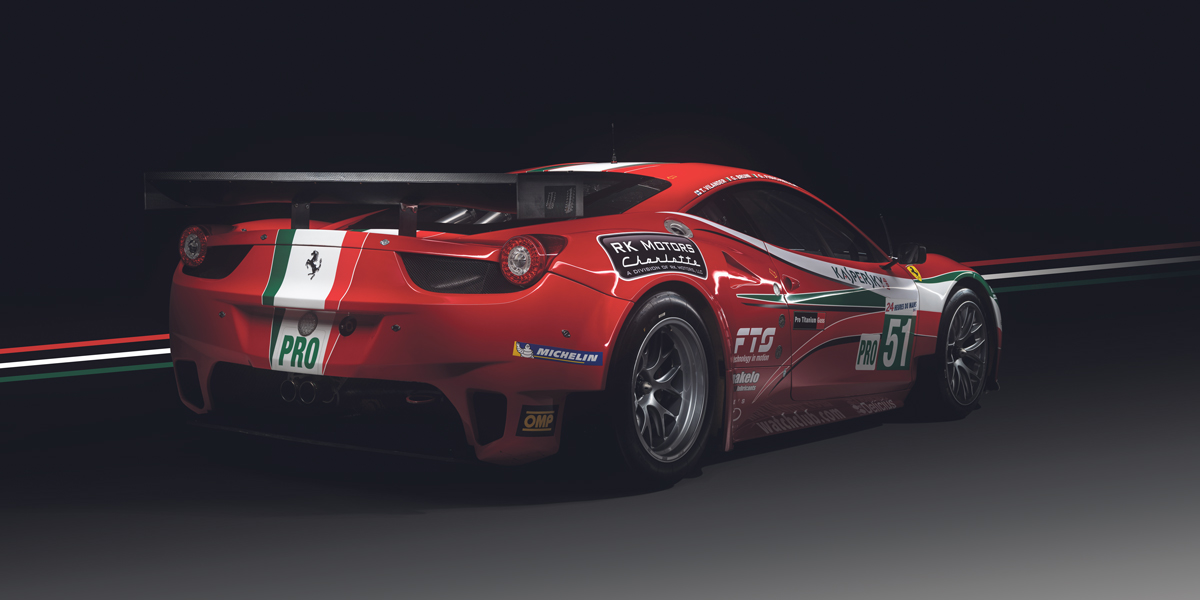
Fujifilm GFX100 II Goes Automotive
Posted on Mar 22, 2024
A camera to get revved up about
Automotive exotica and the FUJIFILM GFX100 II. For photographer Rupert Cobb, it’s a podium-topping combination
Advertisement feature
Photographing the world’s most prestigious motorbikes and cars against an infinity cove large enough to showcase up to three cars at a time, Rupert Cobb is passionate about telling the history inherent in every nut, bolt and serial number.
“A lot of passion has gone into these vehicles, so it’s our responsibility to continue that passion,” he reasons. “With the infinity cove, it’s all about quality bounced light – Fujifilm’s colour space works incredibly well with bounced tungsten light. We still use old fifties lighting since it’s the only other light source as smooth as the thing in the sky! If you use a nice lens on a tungsten light and focus it in on the wall of the cove, you can highlight the curves of a car in such a beautiful way. Marry that with the FUJIFILM GFX System and it’s a partnership made in heaven.”
The exact tool used to visually describe the vehicles’ majesty is the 102-megapixel, medium format sensor of the FUJIFILM GFX100 II.
“I want to make everything as future-proof and high-quality as possible, and photographing medium format gives that detail,” he continues. “One of our clients is very specific about the detail shots. The pictures must have a narrative, a story in the image.
“You might think ‘how can there be a story?’. Yet, behind the dashboard of this Ferrari are all the stickers and signatures from the pits of Le Mans as well as races around Europe. If you shoot medium format, you have got every detail and can almost smell the exhaust smoke of that day.”
Cobb has coupled his GFX100 II with a pair of tilt-shift lenses in FUJINON GF30mm f/5.6 T/S and GF110mm f/5.6 T/S Macro.
“These tilt-shift lenses represent another jump in quality. The 110mm is a macro-capable lens long enough to bring you back and out of the way of your own light source. You can move the plane of focus to where you require, while still keeping a narrow depth-of-field. The other benefit is you can stay in the sweet spot of the lens. It’s worth spending time finding what works for you.”
Cobb’s route into the Fujifilm system began when he bought the FUJIFILM X-E2 second hand and “instantly fell in love with the colour space and how flexible it was. So, I looked for what an equivalent might be to what I was using in the studio. We’re all about getting it right in camera – and the GFX100 proved to be a game changer overnight.
“There’s a texture to the sensor that I love – I’m always after that,” comments Cobb on the look of the visuals from the latest GFX100 II. “The 30mm tilt-shift lens is good for dashboard shots, but has also proved very useful for some unusual high-angle shots where we were able to come up really high. But instead of being over the top of the car, we could be behind it, yet still tilt the angle of perspective so it seemed we were more directly over the car than we actually were. The 30mm lens is phenomenal for levelling out and pulling back those parallels.”
Fuel in the creative tank
Cobb utilises the Film Simulation digital presets on the camera too – especially when a client needs sight of images quickly and there isn’t time to process Raw files.
“I used to shoot on FUJIFILM Velvia slide film, so I love the fact that you can emulate that look, alongside still shooting Raw. On a recent urgent job, the Film Simulations enabled us to deliver an advanced package to the client. They were over the moon with it, and we could follow up with any changes using the Raw.”
In terms of shooting video on the GFX100 II – while noting this is a road less travelled – Cobb sees the advantages for “when there’s a need for upright videos. Once I’ve made the still, I can also create a quick high-res spin around the car. Video doesn’t feel like a compromise on the GFX100 II; it looks great out of the box and I aim to use video with the tilt-shift lenses.”
He adds that the camera has a couple of additional interesting modes, including focus stacking. “We photograph many racing cars with amazing race histories,” he enthuses. “If we’re pressed for time, I’ll do a stacked-focus shot from the passenger side right through to the driver’s seat – then choose what I want to be in focus later, while still using the sweet spot of the lens. I can create this large image, from which I can make other little images if I want – still of sufficient quality to print in a magazine.
“Pixel Shift Multi-Shot mode is also great fun. From the far end of the studio, I can shoot a full side-on of a car. If I do that with Pixel Shift, I’ve then got the detail of every nut on every wheel.”
Cobb concludes: “What I love about the Fujifilm ethos is they’re not trying to compete with others. They have taken a different angle, saying: ‘OK, crop sensor for street photography, then we’re going to get a bigger sensor and make the glass work for that’. It’s like a loop back to serious majestic photography.”
This advertisement feature was originally published in Issue 114 of Photography News.
Don’t forget to sign up to receive our newsletter below, and get notified about the new issue, exclusive offers and competitions.
Have you heard The Photography News Podcast? Tune in for news, techniques, advice and much more! Click here to listen for free.







